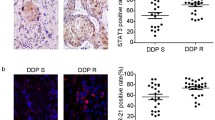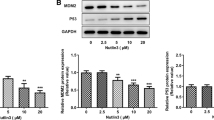Abstract
The mammalian target of rapamycin (mTOR) has recently emerged as a promising target for therapeutic anti-cancer interventions in several human tumors. In present study, we investigated the expression of mTOR, and subsequently examined its relationship with clinicopathological factors and the anti-tumor effect of everolimus (also known as RAD001) in oral squamous cell carcinoma (OSCC). The expression of phosphorylated mTOR (p-mTOR) was immunohistochemically evaluated in specimens obtained from 70 OSCC patients who underwent radical surgery. The relationships between the expression of p-mTOR and clinicopathological factors and survival were determined. We also investigated the effect of everolimus on the OSCC cell lines, SAS, HSC-2, HSC-3, HSC-4, OSC-20, SCC25 and Ca9-22 by the MTT assay. We further evaluated whether mTOR contributed to cell functions by blocking its activity with everolimus, and confirmed the direct target by the Matrigel invasion assay, wound healing assay and Western blotting. p-mTOR was overexpressed in 37 tumors (52.8 %), and correlated with the T classification, N classification, and survival rate (P < 0.05). The treatment with everolimus significantly inhibited cell growth, and significantly reduced the expression of p-mTOR, downstream signaling proteins, and hypoxic related proteins as well as invasion and migration potentials (P < 0.05). The results of the present study suggest that everolimus may represent an attractive approach for the future treatment of OSCC.





Similar content being viewed by others
References
Mao L, Hong WK, Papadimitrakopoulou VA (2004) Focus on head and neck cancer. Cancer Cell 5:311–6
Seiwert TY, Cohen EE (2005) State-of-the-art management of locally advanced head and neck cancer. Br J Cancer 92(8):1341–8
Rogers SN, Brown JS, Woolgar JA et al (2009) Survival following primary surgery for oral cancer. Oral Oncol 45(3):201–11
Shaw RJ, Cantley LC (2006) Ras, PI (3) K and mTOR signaling controls tumor cell growth. Nature 441(7092):424–30
Liu FY, Zhao ZJ, Li P et al (2010) Mammalian target of rapamycin (mTOR) is involved in the survival of cells mediated by chemokine receptor 7 through PI3K/Akt in metastatic squamous cell carcinoma of the head and neck. Br J Oral Maxillofac Surg 48:291–6
Semenza GL (2003) Targeting HIF-1 for cancer therapy. Nat Rev Cancer 3:721–32
Laplante M, Sabatini DM (2012) mTOR signaling in growth control and disease. Cell 149(2):274–93
Pouysségur J, Dayan F, Mazure NM (2006) Hypoxia signaling in cancer and approaches to enforce tumour regression. Nature 441:437–43
Hohwer N, Cramer T (2011) Hypoxia-mediated drug resistance: novel insights on the functional interaction of HIFs and cell death pathways. Drug Resist Updat 14:191–201
Brown LM, Cowen RL, Debray C et al (2006) Reversing hypoxic cell chemoresistance in vitro using genetic and small molecule approaches targeting hypoxia inducible factor-1. Mol Pharmacol 69:411–8
Liu L, Ning X, Sun L et al (2008) Hypoxia-inducible factor-1 alpha contributes to hypoxia-induced chemoresistance in gastric cancer. Cancer Sci 99:121–8
Yoshiba S, Ito D, Nagumo T et al (2009) Hypoxia induces resistance to 5-fluorouracil in oral cancer cells via G (1) phase cell cycle arrest. Oral Oncol 45:109–15
Monteiro LS, Delgado ML, Ricardo S et al (2013) Phosphorylated mammalian target of rapamycin is associated with an adverse outcome in oral squamous cell carcinoma. Oral Surg Oral Med Oral Pathol Oral Radiol Endod 115(5):638–45
Hirashima K, Baba Y, Watanabe M et al (2010) Phosphorylated mTOR expression is associated with poor prognosis for patients with esophageal squamous cell carcinoma. Ann Surg Oncol 17(9):2486–93
Bakarakos P, Theohari I, Nomikos A et al (2010) Immunohistochemical study of PTEN and phosphorylated mTOR proteins in familial and sporadic invasive breast carcinomas. Histopathology 56(7):876–82
Xu DZ, Geng QR, Tian Y et al (2010) Activated mammalian target of rapamycin is a potential therapeutic target in gastric cancer. BMC Cancer 10:536
Del Bufalo D, Ciuffreda L, Trisciuoqlio D et al (2006) Antiangiogenic potential of the Mammalian target of rapamycin inhibitor temsirolimus. Cancer Res 66:5549–54
Matsumoto K, Arao T, Tanaka K et al (2009) mTOR signal and hypoxia-inducible factor-1 alpha regulate CD133 expression in cancer cells. Cancer Res 69:7160–4
Okui T, Shimo T, Fukazawa T et al (2010) Antitumor effect of temsirolimus against oral squamous cell carcinoma associated with bone destruction. Mol Cancer Ther 9:2960–9
Okui T, Shimo T, Fukazawa T et al (2013) Novel HSP90 inhibitor NVP-AUY922 enhances the anti-tumor effect of temsirolimus against oral squamous cell carcinoma. Curr Cancer Drug Targets 13:289–99
Huang S, Houghton PJ (2003) Targeting mTOR signaling for cancer therapy. Curr Opin Pharmacol 3:371–7
Motzer RJ, Escudier B, Oudard S et al (2008) Efficacy of everolimus in advanced renal cell carcinoma: a double-blind, randomized, placebo-controlled phase III trial. Lancet 372:449–56
Pavel ME, Hainsworth JD, Baudin E et al (2011) Everolimus plus octreotide long-acting repeatable for the treatment of advanced neuroendocrine tumours associated with carcinoid syndrome (RADIANT-2): a randomised, placebo-controlled, phase 3 study. Lancet 378:2005–12
Burris HA 3rd, Lebrun F, Rugo HS et al (2013) Health-related quality of life of patients with advanced breast cancer treated with everolimus plus exmestane versus placebo plus exemestane in the phase 3, randomizd, controlled, BOLERO-2 trial. Cancer 119(10):1908–15
Fury MG, Lee NY, Sherman E et al (2013) A phase 1 study of everolimus + weekly cisplatin + intensity modulated radiation therapy in head and neck cancer. Int J Radiat Oncol Biol Phys 87(3):479–86
Clark C, Shah S, Herman-Ferdinandez L et al (2010) Teasing out the best molecular marker in the AKT/mTOR pathway in head and neck squamous cell cancer patients. Laryngoscope 20(6):1159–65
Brown RE, Zhang PL, Lun M et al (2006) Morphoproteomic and pharmacoproteomic rationale for mTOR effectors as therapeutic targets in head and neck squamous cell carcinoma. Ann Clin Lab Sci 36(3):273–82
Myoung H, Kim MJ, Lee JH et al (2006) Correlation of proliferative markers (Ki-67 and PCNA) with survival and lymph node metastasis in oral squamous cell carcinoma: a clinical and histopathological analysis of 113 patients. Int J Oral Maxillofac Surg 35(11):1005–10
Dorević G, Matusan-Ilijas K, Babarović E et al (2009) Hypoxia inducible factor-1alpha correlates with vascular endothelial growth factor A and C indicating worse prognosis in clear cell renal cell carcinoma. J Exp Clin Cancer Res 20:28–40
Cao D, Hou M, Guan YS et al (2009) Expression of HIF-1alpha and VEGF in colorectal cancer: association with clinical outcomes and prognostic implications. BMC Cancer 9:432
Oh SY, Kwon HC, Kim SH et al (2008) Clinicopathologic significance of HIF-1alpha, p53, and VEGF expression and preoperative serum VEGF level in gastric cancer. BMC Cancer 8:123
Juengel E, Engler J, Natsheh I et al (2009) Combining the receptor tyrosine kinase inhibitor AEE788 and the mammalian target of rapamycin (mTOR) inhibitor RAD001 strongly inhibits adhesion and growth of renal cell carcinoma cells. BMC Cancer 9:161
Zitzmann K, De Toni EN, Brand S et al (2007) The novel mTOR inhibitor RAD001 (everolimus) induces antiproliferative effects in human pancreatic neuroendocrine tumor cells. Neuroendocrinology 85(1):54–60
Grozinsky-Glasberg S, Rubinfeld H, Nordenberg Y et al (2010) The rapamycin-derivative RAD001 (everolimus) inhibits cell viability and interacts with the Akt-mTOR-p70S6K pathway in human medullary thyroid carcinoma cells. Mol Cell Endocrinol 315:87–94
Nishi T, Iwasaki K, Ohashi N et al (2013) Phosphorylation of 4E-BP1 predicts sensitivity to everolimus in gastric cancer cells. Cancer Lett 331(2):220–9
Miyazawa M, Yasuda M, Fujita M et al (2009) Therapeutic strategy targeting the mTOR-HIF-1alpha-VEGF pathway in ovarian clear cell adenocarcinoma. Pathol Int 59:19–27
Naruse T, Kawasaki G, Yanamoto S et al (2011) Immunohistochemical study of VEGF expression in oral squamous cell carcinomas: correlation with the mTOR- HIF-1α pathway. Anticancer Res 12:4429–37
Otrock ZK, Makarem JA, Shamseddine AI (2007) Vascular endothelial growth factor family of ligands and receptors: review. Blood Cells Mol Dis 38(3):258–68
Sobin LH, Wittekind C (2002) UICC TNM classification of malignant tumours, 6th edn. Wiley, New York
Pinborg JJ, Reichart PA, Smith CJ et al (eds) (1997) World health organization histological typing of cancer and precancer of the oral mucosa, 2nd edn. Springer, New York
Bryne M, Boysen M, Alfsen CG et al (1998) The invasive front of carcinomas. the most important area for tumour prognosis? Anticancer Res 18(6B):4757–64
Acknowledgments
This study was partially supported by Grants 70549609 from the Ministry of Education, Culture, Sports, Science and Technology, Japan.
Conflicts of Interest
None declared.
Author information
Authors and Affiliations
Corresponding author
Rights and permissions
About this article
Cite this article
Naruse, T., Yanamoto, S., Yamada, Si. et al. Anti-Tumor Effect of the Mammalian Target of Rapamycin Inhibitor Everolimus in Oral Squamous Cell Carcinoma. Pathol. Oncol. Res. 21, 765–773 (2015). https://doi.org/10.1007/s12253-014-9888-1
Received:
Accepted:
Published:
Issue Date:
DOI: https://doi.org/10.1007/s12253-014-9888-1




